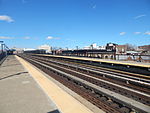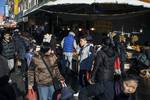Basilica of Regina Pacis
20th-century Roman Catholic church buildings in the United StatesBasilica churches in New York (state)Italian-American culture in New York CityItalianate architecture in New York (state)Roman Catholic Diocese of Brooklyn ... and 3 more
Roman Catholic churches completed in 1951Roman Catholic churches in BrooklynShrines to the Virgin Mary

The Basilica of Regina Pacis (Latin for Queen of Peace) is a Catholic parish church located in the Bensonhurst section of Brooklyn, New York, under the Roman Catholic Diocese of Brooklyn. The church was built as a votive shrine, within the then-Parish of St. Rosalia (later renamed St. Rosalia-Regina Pacis Parish). The original parish church, built in 1905, was considered the "Mother Church of Italian immigrants" of the diocese.The church was raised to the status of a minor basilica by Pope Benedict XVI in November 2012.In June 2017, the diocese closed the Church of St. Rosalia, establishing the basilica as the parish church.
Excerpt from the Wikipedia article Basilica of Regina Pacis (License: CC BY-SA 3.0, Authors, Images).Basilica of Regina Pacis
66th Street, New York Brooklyn
Geographical coordinates (GPS) Address Nearby Places Show on map
Geographical coordinates (GPS)
| Latitude | Longitude |
|---|---|
| N 40.626666666667 ° | E -74.003611111111 ° |
Address
Virginia Reginae School
66th Street 1221
11219 New York, Brooklyn
New York, United States
Open on Google Maps







